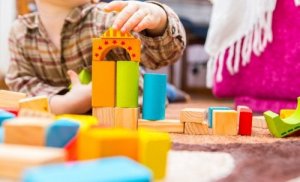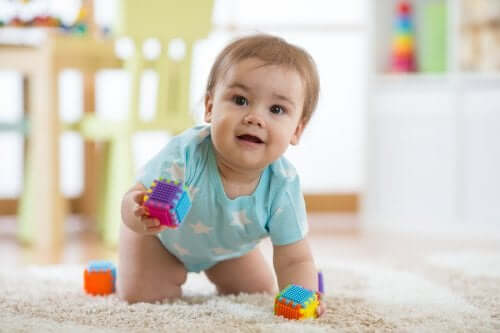Choosing Toys Intelligently at Every Age

When little ones play, they learn all about the world around them. Not only is play beneficial when it comes to brain development, but also in the learning of emotional intelligence and social skills. That’s why choosing toys intelligently for children at every age is important for adults to know how to do.
Exploring the world around them
During children’s first year of life, the goal is for them to explore the world around them with their five senses. Their mouths are their favorite spot to place any object they can get their hands on. This is the way they discover if it’s rough, hard, sticky, soft, etc.
Starting at the age of 4 months, infants start to grasp medium-sized objects with their hands. A month or two later, they begin to pass these objects from one hand to the other. Around the age of 9 months, babies start to pick up objects between their thumbs and index finger (pincer grasp).
When children start to interact with other babies, this marks the beginning of their social relationships. They acquire language skills and advance in their knowledge of how different things relate to one another. They’re already able to perceive the smell, sound and taste of objects, and also begin to understand how they work.
Choosing toys intelligently: Children’s personalities and preferences
With all of this in mind, the importance of choosing toys intelligently according to a child’s age is undeniable. These “work tools” will be a child’s closest companion in this process. So, it’s important to choose toys wisely, using specific criteria and keeping their function in mind.
At first, we recommend looking for toys that your child shows interest in and wants to play with. These should consist of durable materials and solid colors. And of course, they shouldn’t contain toxic substances or sharp or pointy edges.
For children who display hyperactivity, attention games are a great option. In the case of children who are especially shy, games that help them socialize can make a big difference. As you can see, a child’s personality plays a vital role when choosing toys intelligently.

Be careful not to indulge
Stay away from the temptation to indulge your children with toys as a means of behavior control. They’ll soon lose interest in these objects. It’s best not to use these tools in order to punish and reward your little ones, as they’ll quickly lose their true value.
At the same time, avoid giving your children too many toys. Doing so will only lead them to become easily bored and will stunt their creativity. Let your family members know this as well so that they don’t saturate your kids with new toys every time they see them.
Remember: Babies have no notion of prices
Just because a toy is expensive doesn’t mean it’s the best for your baby. Technological toys should always be interactive. What’s more, mothers and fathers should be careful to limit how much time their children spend playing with them.
It’s also important to avoid gender stereotypes when choosing toys. Cars don’t necessarily have to be for boys, nor are girls the only ones who can play with toys. Allow children to choose whatever toys interest them without limiting their selection according to gender.
Children’s first toys
During the first days and months of life, there are toys that serve a specific purpose. Musical mobiles are often the first toys that our little ones receive. These objects stimulate their ability to pay attention. Mirrors are also an added bonus, as they help babies gain awareness of themselves.
Towers for piling up rings of different sizes and colors are ideal for developing motor skills in infants. At the same time, parents can use them to teach colors and numbers.
Toys on wheels that babies can push and pull are especially useful in developing balance and motor skills… both of which are necessary when children take their first steps.
After children hit their first year
From the time children reach their first birthday, they have the ability to stack blocks with greater precision. They can also pick up a telephone to “talk.” What’s more, you’ll notice they have more awareness regarding movement and displacement. Therefore, during this stage, shape sorters, ride-on toys, and tricycles are the best options.
At around the age of 18 months, we can give toddlers chalkboards, dolls, animals, and musical instruments to create their own stories. Between the ages of 2 and 3, children begin to play through imitation. Phones, shovels, puzzles, paints, and dolls are all appropriate toys at this age.
Up until children are around 5 years old, they’re in a stage of asking questions, playing with friends, and even singing. So, puppets, stories, and bikes will allow them to have fun and learn.

Scooters, remote control cars, trivia games, scientific experiments… these are all excellent toys for children between the ages of six and eight. During this time period, children learn to read and write as well as carry out simple mathematical operations.
If you’re looking to choose toys intelligently for kids between the ages of 9 and 11, we’ve also got some great ideas. Strategy and reflection games, experiments, and sports equipment are all excellent options. By now, children are interested in activities that have a higher degree of complication. And video games, books, and music play a major role in the lives of children ages 12 and up.
As parents, it’s important that we choose intelligently the toys that our children play with at each stage of development. In doing so, we contribute to their growth and learning and guarantee harmonious development based on their abilities.
When little ones play, they learn all about the world around them. Not only is play beneficial when it comes to brain development, but also in the learning of emotional intelligence and social skills. That’s why choosing toys intelligently for children at every age is important for adults to know how to do.
Exploring the world around them
During children’s first year of life, the goal is for them to explore the world around them with their five senses. Their mouths are their favorite spot to place any object they can get their hands on. This is the way they discover if it’s rough, hard, sticky, soft, etc.
Starting at the age of 4 months, infants start to grasp medium-sized objects with their hands. A month or two later, they begin to pass these objects from one hand to the other. Around the age of 9 months, babies start to pick up objects between their thumbs and index finger (pincer grasp).
When children start to interact with other babies, this marks the beginning of their social relationships. They acquire language skills and advance in their knowledge of how different things relate to one another. They’re already able to perceive the smell, sound and taste of objects, and also begin to understand how they work.
Choosing toys intelligently: Children’s personalities and preferences
With all of this in mind, the importance of choosing toys intelligently according to a child’s age is undeniable. These “work tools” will be a child’s closest companion in this process. So, it’s important to choose toys wisely, using specific criteria and keeping their function in mind.
At first, we recommend looking for toys that your child shows interest in and wants to play with. These should consist of durable materials and solid colors. And of course, they shouldn’t contain toxic substances or sharp or pointy edges.
For children who display hyperactivity, attention games are a great option. In the case of children who are especially shy, games that help them socialize can make a big difference. As you can see, a child’s personality plays a vital role when choosing toys intelligently.

Be careful not to indulge
Stay away from the temptation to indulge your children with toys as a means of behavior control. They’ll soon lose interest in these objects. It’s best not to use these tools in order to punish and reward your little ones, as they’ll quickly lose their true value.
At the same time, avoid giving your children too many toys. Doing so will only lead them to become easily bored and will stunt their creativity. Let your family members know this as well so that they don’t saturate your kids with new toys every time they see them.
Remember: Babies have no notion of prices
Just because a toy is expensive doesn’t mean it’s the best for your baby. Technological toys should always be interactive. What’s more, mothers and fathers should be careful to limit how much time their children spend playing with them.
It’s also important to avoid gender stereotypes when choosing toys. Cars don’t necessarily have to be for boys, nor are girls the only ones who can play with toys. Allow children to choose whatever toys interest them without limiting their selection according to gender.
Children’s first toys
During the first days and months of life, there are toys that serve a specific purpose. Musical mobiles are often the first toys that our little ones receive. These objects stimulate their ability to pay attention. Mirrors are also an added bonus, as they help babies gain awareness of themselves.
Towers for piling up rings of different sizes and colors are ideal for developing motor skills in infants. At the same time, parents can use them to teach colors and numbers.
Toys on wheels that babies can push and pull are especially useful in developing balance and motor skills… both of which are necessary when children take their first steps.
After children hit their first year
From the time children reach their first birthday, they have the ability to stack blocks with greater precision. They can also pick up a telephone to “talk.” What’s more, you’ll notice they have more awareness regarding movement and displacement. Therefore, during this stage, shape sorters, ride-on toys, and tricycles are the best options.
At around the age of 18 months, we can give toddlers chalkboards, dolls, animals, and musical instruments to create their own stories. Between the ages of 2 and 3, children begin to play through imitation. Phones, shovels, puzzles, paints, and dolls are all appropriate toys at this age.
Up until children are around 5 years old, they’re in a stage of asking questions, playing with friends, and even singing. So, puppets, stories, and bikes will allow them to have fun and learn.

Scooters, remote control cars, trivia games, scientific experiments… these are all excellent toys for children between the ages of six and eight. During this time period, children learn to read and write as well as carry out simple mathematical operations.
If you’re looking to choose toys intelligently for kids between the ages of 9 and 11, we’ve also got some great ideas. Strategy and reflection games, experiments, and sports equipment are all excellent options. By now, children are interested in activities that have a higher degree of complication. And video games, books, and music play a major role in the lives of children ages 12 and up.
As parents, it’s important that we choose intelligently the toys that our children play with at each stage of development. In doing so, we contribute to their growth and learning and guarantee harmonious development based on their abilities.
All cited sources were thoroughly reviewed by our team to ensure their quality, reliability, currency, and validity. The bibliography of this article was considered reliable and of academic or scientific accuracy.
- Instituto de consumo de Extremadura. Un juguete para cada edad. Extraído de: https://saludextremadura.ses.es/filescms/incoex/uploaded_files/CustomContentResources/UN_JUGUETE_PARA_CADA_EDAD.pdf
- AIJU. (2019). Juego y juguete 2019/2020 – Guía AIJU. AIJU, Instituto Tecnológico de Producto Infantil y Ocio. https://guiaaiju.com/guias/Guia-AIJU-2019-20.pdf
This text is provided for informational purposes only and does not replace consultation with a professional. If in doubt, consult your specialist.








